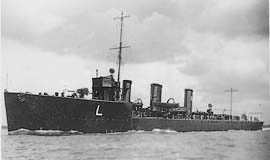Technical innovations
Leonidas, together with Lucifer, was one of two experimental destroyers ordered in 1912 from Parsons to be fitted with fully geared turbines. Gearing meant that the turbine itself could run at higher speeds than the propeller, which improved efficiency. Two previous experimental destroyers, Badger and Beaver had been ordered in 1911 which used gearing for the high pressure (HP) turbines but not for the low pressure (LP) ones. Sufficiently robust gearboxes were at that time experimental and were only just being produced by Parsons who had developed innovative gear cutting equipment. Ships propellers rotated at a maximum speed of 380 rpm, while the LP turbines ran at 1800 rpm and the HP at 3000 rpm. It was anticipated that the additional gearing would produce an overall 10% increase in efficiency, ranging from 9% at full power to 26% at low power, since turbines are more efficient at higher speeds and performance particularly suffered when the engines were running slowly. Comparative tests indicated the savings equated to the ships being able to remain on patrol at cruising speeds for an extra two days as compared to a ship using partially geared turbines. Cost of the ships increased because of providing gearboxes, but this was partly offset against a reduction in the total necessary power from the turbine to achieve a given speed, meaning that smaller and cheaper turbines could be used. Other ships of the class built without LP gearing required 24,500 shp compared to 22,500 shp for this design. [1]
Two designs were produced for the ships propellers because of disagreement between the admiralty and Parsons on the better design. For the same overall dimensions, Parsons used a blade area of 54 square feet (5.0 m2) while the admiralty preferred 42.5 sq ft (3.95 m2). The introduction of gearing meant that bearings holding the shafts were now subject to large lateral forces where the gears pushed against each other. This was a significant difficulty in gearbox design but was overcome by the introduction of the new Michell tilting-pad fluid bearing. This was first employed in 1913 on a cross-channel steamer, Paris built by Denny of Dunbarton which also used geared turbines, and then on Leonidas and Lucifer. Traditional bearings were found unable to support the forces in turbine gearboxes but also had higher friction in more traditional application with reciprocating engines. It was estimated that the reduced frictional losses on new bearings introduced throughout the fleet saved the admiralty £500,000 in reduced fuel consumption in 1918. [2] [3]
This page is based on this
Wikipedia article Text is available under the
CC BY-SA 4.0 license; additional terms may apply.
Images, videos and audio are available under their respective licenses.
